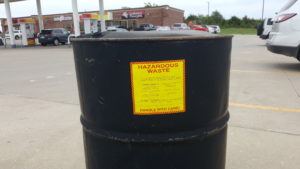Hazardous waste is defined at 49 CFR 171.8 of the Hazardous Materials Regulations (HMR) of USDOT/PHMSA as follows:
Hazardous waste, for the purposes of this chapter, means any material that is subject to the Hazardous Waste Manifest Requirements of the U.S. Environmental Protection Agency specified in 40 CFR part 262.
|
Contact me with any questions you may have about the generation, identification, management, and disposal of hazardous waste Daniels Training Services, Inc. 815.821.1550 |
So, to understand USDOT/PHMSA’s definition of a hazardous waste we must refer to the regulations of the USEPA. The regulations of the USEPA at 40 CFR 262, subpart B describe the Manifest Requirements applicable to Small and Large Quantity Generators. This means only the following hazardous waste generator categories are subject to the requirements of 40 CFR 262, subpart B for the uniform hazardous waste manifest:
Not included in these regulations, i.e., not subject to the Hazardous Waste Manifest Requirements of the USEPA at 40 CFR 262, subpart B, is the following hazardous waste generator category:
- Very small quantity generator of hazardous waste (VSQG). Formerly known as the conditionally exempt small quantity generator of hazardous waste (CESQG).
The factors for determination of hazardous waste generator categories are summarized below:
- Large quantity generator:
- Generate ≥1,000 kg (2,200 lb) of hazardous waste in calendar month.
Or…
-
- Generate >1 kg (2.2 lb) acute hazardous waste or >100 kg (220 lb) acute hazardous waste spill residue in a calendar month.
- Small quantity generator:
- Generate >100 kg (220 lb) but <1,000 kg (2,200 lb) of hazardous waste in calendar month.
And…
-
- Generate ≤1 kg (2.2 lb) acute hazardous waste and ≤100 kg (220 lb) acute hazardous waste spill residue in a calendar month.
- Very small quantity generator:
- Generate ≤100 kg (220 lb) hazardous waste in calendar month.
And…
-
- Generate ≤1 kg (2.2 lb) acute hazardous waste and ≤100 kg (220 lb) acute hazardous waste spill residue in a calendar month.
|
Still not sure of your hazardous waste generator category? Take this short survey |
When determining your hazardous waste generator category, be sure to count correctly: Counting Hazardous Waste for the Generator Category Determination
Q: My state mandates the use of the uniform hazardous waste manifest for non-RCRA hazardous waste (California) / special waste (Illinois) / non-hazardous industrial solid waste (Texas) / liquid industrial by-product (Michigan), does that mean it is also a hazardous waste per USDOT/PHMSA?
A: No. The definition of hazardous waste in the HMR references the requirement to use the uniform hazardous waste manifest (40 CFR part 262). It is not impacted by the regulations of a state. How a state chooses to manage waste under its RCRA authorization does not affect USDOT/PHMSA’s definition of hazardous waste.
Q: My state doesn’t recognize the VSQG category (California) / has an additional generator category (Kansas SQG). How does that affect USDOT/PHMSA’s classification of hazardous waste?
A: It doesn’t. Just like the previous Q&A, the regulations of a state do not affect the USDOT/PHMSA definition / classification of hazardous waste.
